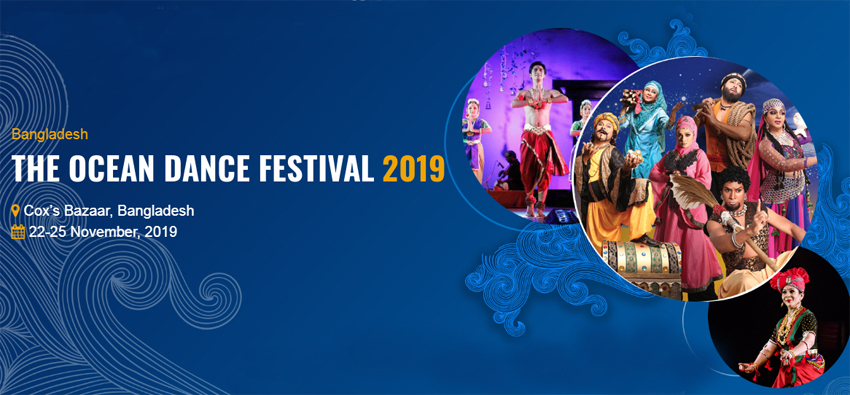Visionary Kathak Guru, Musician, Scholar and Poet Acharya Pt Sukhdev Maharaj can be credited with bringing the renaissance in India towards the perception of hereditary female performers of Kathak, through his methodology of shifting the focus of the content and narrative entirely to subjects within the realm of sanatana dharma.
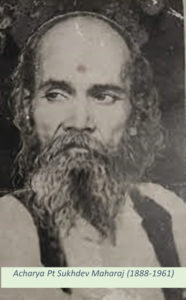 Pt Sukhdev Maharaj was a member of the Royal Court of Nepal, and his second wife Matsya Kumari was related to Nepal royal family. In the 1920s, Sukhdev Maharaj met Tagore who encouraged him to revive Kathak and elevate it to a dignified status. Sukhdev Maharaj introduced reforms to revive Kathak, especially in Varanasi, by including religious elements -unlike what the nautch girls did – and it slowly became popular. He also taught Kathak to his daughters Alaknanda, Tara, Dhanno (later Sitara Devi) and sons Chaube and Pande. They returned to Varanasi and set up a dancing school where the daughters of local prostitutes were also admitted, and Sukhdev Maharaj battled social ostracism to popularize Kathak. (Khokhar,1984)
Pt Sukhdev Maharaj was a member of the Royal Court of Nepal, and his second wife Matsya Kumari was related to Nepal royal family. In the 1920s, Sukhdev Maharaj met Tagore who encouraged him to revive Kathak and elevate it to a dignified status. Sukhdev Maharaj introduced reforms to revive Kathak, especially in Varanasi, by including religious elements -unlike what the nautch girls did – and it slowly became popular. He also taught Kathak to his daughters Alaknanda, Tara, Dhanno (later Sitara Devi) and sons Chaube and Pande. They returned to Varanasi and set up a dancing school where the daughters of local prostitutes were also admitted, and Sukhdev Maharaj battled social ostracism to popularize Kathak. (Khokhar,1984)
Early Life and Family- Rubaroo with Kathak
Pt Sukhdev Maharaj was born in August 1888 in Kathmandu, Nepal. His father Ramdas Mishra ji was an expert vocalist and sarangi player. His name appears as Shukdev (शुकदेव) and sometimes Shukre Maharaj (शुक्रे महाराज). However, the name Sukhdev Maharaj is more well known. Sukhdev Maharaj received Talim of Vocal music from his own father as well as from Bade Ramdas ji and Sahay ji (Pashupati Mishra) of Banaras.

After eighteen years of rigorous Talim, he was appointed as the Rajgayak (court singer) at the royal court of Nepal. It was the Royal court of Nepal where he experienced the glory of Kathak for the first time, watching the performance of Guru Bindadin Maharaj and decided to dive into the depths of this art form. A word is that Sukhdev Maharaj ji’s cousin Nanaku Maharaj was the court dancer and was a disciple of Bindadin Maharaj ji. He also inspired Sukhdev Maharaj to learn dance (Apte, 2015).
Sukhdev Maharaj was married to Badko Devi, but in Nepal Sukhdev Maharaj ji had a second marriage to Matsyakumari (Mahalo Devi) who was the daughter of Rajguru at the Nepal court. With the sole purpose to spread this art to the masses, Pandit Sukhdev Maharaj ji left the royal courts and returned to Banaras.

Sukhdev Maharaj had nine children from his two wives: Master Krishnaprasad, Durgaprasad, Pandeya (Pandey Maharaj), Chaturbhuj Mishra (Chaubey Maharaj), Tiwari, Alaknanda, Tara, Sitara, Shail and Bindu.
The below family tree given by Pt Teertahram Azad gives the family tree. The family in totality thus belonged to the community of ‘Kathiks’. The Kathaks are considered Brahmins, but of lower category, they cannot receive daan (gifts), or perform any sacred rituals but are allowed to perform Katha (enacting mythological stories in people’s houses, or temple courtyards), according to the former Mahant (priest) of the Kashi Vishwanath Temple, Varanasi and priest Nankphopha from Gaya (Jafa, 2015).

Reformation and Renaissance – Sangharsh for Kathak
When Sukhdev Maharaj returned to Varanasi from Nepal, he started teaching Kathak to his children which received tremendous social criticism. He was ostracized from his community and was forced to move to Kolkata for a time period. He brought his children to the gurus of Lucknow Gharana who continued to train them (Vaysyayan,2019). He wanted Kathak to be widely accepted by the audience rather than being relegated only in the temples, courts, kothas and mehfils.
Sukhdev Maharaj initiated his three daughters into the performing space when ladies of the stage were always the tawaifs (courtesans) who, after 1857, were perceived not as performers but as mere entertainers, and even prostitutes. However, this bold step was well strategized even at the cost of being ostracized by his own community. Patronage of the stage at that time was confined to the aristocracy or the temple authorities. Sukhdev Maharaj was not backed by any prominent aristocrats and wanted them to achieve recognition in their own right and earn respectability for the profession (Jafa,2015).
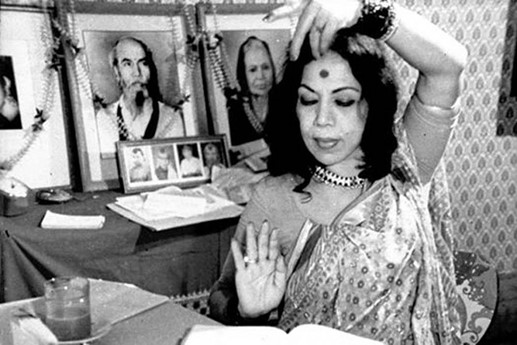
In Kathak dance, until the 1950s, the majority of performers were the women tawaifs, but the power to transmit the art was with the male gurus. The technical repertoire of the male dancer was significantly different to what tawaifs performed, which was framed within the context of the enactment of largely sophisticated sensual poetic imagery through music and multi-layered interpretative language of gestures (abhinaya). The entire objective of the performance of the tawaif was to entrance the clients and earn a livelihood through performance. This is why the entry of Sitara and her sisters on stage was a step towards providing the Kathak dance ‘respectability.’ Sukhdev Maharaj planned for his daughters not only to learn what usually was performed by the male dancers, but he also drew the content of the natya or the expressive aspects of their dance from symbols, dance treatises like Natyashastra and literature of Hindu mythology.
In the words of Sitara Devi (Jafa, 2015)
“My father would simply draw from the mythological sacred content referring to both traditions of Vaishnaivsm and Shaivism. He would create compositions, dance dramas from leelas of Rama, Krishna, Lord Shiva. Vibrancy of these gods would resound in the mnemonic syllables, and use of poetic language, or in the songs chosen. We were Brahmin girls, and even as we understood and performed shringar (reference to erotic poetry), my father insisted on the interpretation that went beyond the erotic into the world of metaphysical…”
Academic Temperament – Sahitya and Kathak
Pt Sukhdev Maharaj is said to have studied the Natyashastra (Azad,2015). He focused on bringing to life stories of Shiv-Parvati and Radha-Krishna. His study also enabled him to strongly re-introduce in Kathak, the tandava aspects and pieces based on tandava or uddhata nritya. With traditional knowledge of Sanskrit, he further extensively used Brij Bhasha and Hindi to expand the narrative repertoire for Kathak. He has composed many Kavitts, Parans along with Kali tandava, Shiv Tandava, Durga tandav and kathanaks on Radha-Krishna. He was also conferred a D.Litt in Hindi by the Bharatiya Hindi Shiksha Parishad.

According to Dr Puru Dadheech, Pt Sukhdev Maharaj was the one who made prevalent the practice of chakkars on the heel in contrast to the previous tradition of chakkars performed on the flat foot. This enabled faster and more spins to be taken within the same time frame. He also experimented with ghungroos and started using metal wire along with the thread of ghungroo so that the ghungroos remained intact even if the cotton thread is torn.
Popularity without Adulteration – Bollywood and Kathak
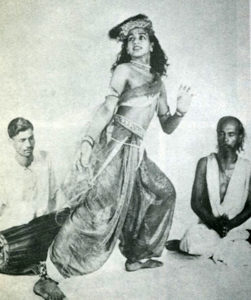
Jayanti Mala Mishra shared the journey of Sitara Devi from Benaras to Mumbai at the Panchatattva Festival 2019. In 1940, Niranjan Sharma, who wanted traditional ‘Indian’ dance in his film visited Sukhdev Maharaj in Benaras and selected a 12-year-old Sitara. Hilariously, she was accompanied by her family of 30 members to Mumbai for that foray into films. The dance was a combination of folk and other movements from classical dance, that lead to the creation of the category ‘Filmy Dance’. Later this came to be known as the Bollywood style of dancing, which till date draws upon different dance forms to create unique movements. This was also the period when Pt Lacchu Maharaj had started choreographing in films and subsequently Sitara Devi started learning from him. This reached a pinnacle with the casting of Pt Gopi Krishna in the role of Girdhar for the blockbuster movie ‘Jhanak Jhanak Payal Baje’. Though Sukhdev Maharaj ji refused to be cast in the role of the Kathak Guru, the character was modelled upon him and portrayed by Keshavrao Daate. His vision in taking traditional narratives to the popular medium was much ahead of his times and shows his farsightedness. In fact, the popularity that Kathak enjoys today in mainstream media can be credited to these visionary strategies.
Repository of Compositions – Kavitt and Kathak
Dr Manjiri Deo (2004) in her PhD research work completed under the guidance of Dr Vibha Dadheech has compiled a repository of Kavitt composed by Pt Sukhdev Maharaj. A few of them have been compiled and presented below.
1. Shiv Tandav in Teentaal (Chatushra Jaati)
Pt Birju Maharaj Mentions that Gattha, Hattha, Gattha Tho etc were bols that were used by Pt Acchan Maharaj and such bols came from long-standing awadh traditions. In the below kavitt Gattha and Gat are both used by Sukhdev Maharaj

2. Shiv Nritya Kavitt in Teentaal
A beautiful kavitt where the dance of Shiva accompanied by the cosmic damru inspires all the gods to dance.
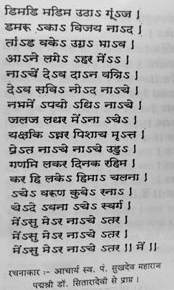
3. Durga Paran – Mishra Jaati
This paran is very popular even today in dancers of all gharanas of Kathak

4. Maharaas Paran
In this paran the various shringarik anga of Kathak like katakasha, kasak masak, thirkan have been used to create the imagery of the dance.
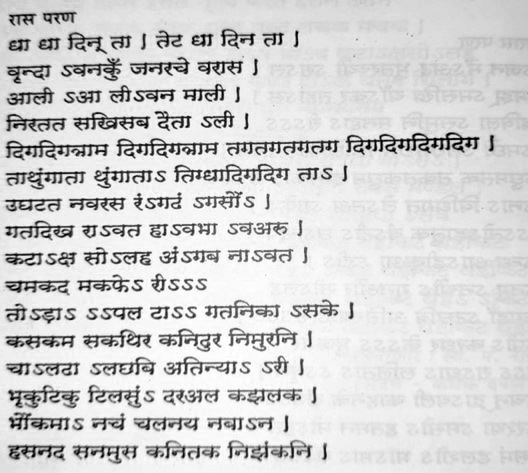
5. Radha Kavitt
In deep metaphysical thought, Radha is the Dhara or river of longing. That has been beautifully encapsulated in this Kavitt.
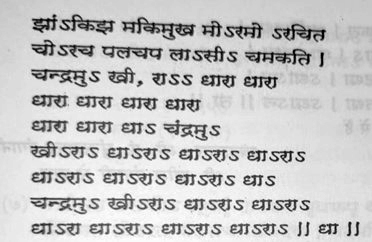
6. Hori Kavitt
In this Kavitt some of the major Sakhis of Radha as given in Rati Manjari are mentioned – Lalita and Chandravali. There can also be an interpretation of these being different names for Radha herself, based on how the dancer wishes to portray.
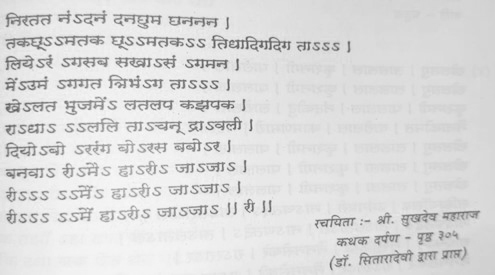
Conclusion
The contribution of Pt Sukhdev Maharaj has a number of facets which have not been fully appreciated by the Kathak students of today. His visionary approach to Kathak is something Kathak dancers must imbibe today, especially in the time of the pandemic, to ensure that Kathak moves forth, yet starts unadulterated in its core ethos.
Works Cited:
Apte, M. Pandit Gopikrishna yanchi kathak nrutyashailee ek abhyas. Accessed via Shodhganga, April 2015.
Azad, Teerathram. Kathak Gyaneshwari. Nateshwar Kala Mandir, 2015
Deo, Manjari. Kathak Nritya Mein Kavitt Chhand. Shree Ganesh Nritya Kalamandir, Thane, 2010.
Khokar, M. Traditions of Indian Classical Dance. Michigan: Clarion Books, 1984.
Jafa, N. The Dancer And The Dance , 7 January 2015.
Vatsyayan K. Interview with Sitara Devi , 2019.
Pictures provided by the author.








